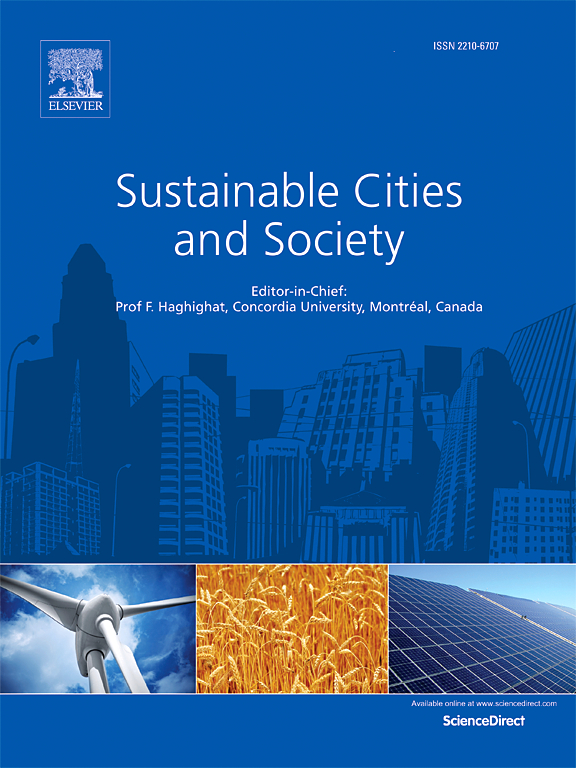Synergistic optimization and interaction evaluation of water-energy-food-ecology nexus under uncertainty from the perspective of urban agglomeration
IF 10.5
1区 工程技术
Q1 CONSTRUCTION & BUILDING TECHNOLOGY
引用次数: 0
Abstract
Faced with resource scarcity and accelerated urbanization, the synergistic optimization of water, energy, and food resources is crucial for urban agglomeration. This study focuses on the Chengdu-Chongqing Economic Circle (CCEC) with the aim of achieving the following three specific objectives: (1) constructing a synergistic optimization model for the Water-Energy-Food-Ecology Nexus (WEFEN) in urban agglomeration; (2) developing the Basic Trade-off Solution (BTS) to enhance social, economic, and ecological benefits; and (3) analyzing the impact of different factors within the water, energy, and food systems on the spatial distribution of ecological footprints and their interactions. To achieve these objectives, this study innovatively integrates water footprint theory, robust coefficients, multi-strategy meta-heuristic optimization algorithms, and compromise programming (CP) techniques, significantly improving the model's ability to allocate water and land resources under uncertainty. Furthermore, the Optimal Parameters-Based Geographic Detector (OPGD) is introduced, revealing that electricity consumption is the primary driver of the spatial distribution of ecological footprints. It is also found that the orthogonal interaction between food and energy system factors significantly amplifies the spatial response of ecological footprints. The results demonstrate that the proposed BTS, under the dual uncertainty of surface water supply and economic loss risks, can enhance social benefits, improve the economic efficiency of irrigation water, and reduce ecological footprints. This study provides a solution for optimizing water and land resource patterns under the trade-offs between social, economic, and environmental relations, supporting the achievement of SDG 11.a for the sustainable development of urban agglomeration.
城市群视角下不确定条件下水-能-粮-生态关系的协同优化与交互评价
面对资源短缺和城市化进程加快,水、能源、粮食资源协同优化对城市群发展至关重要。本文以成渝经济圈为研究对象,旨在实现以下三个具体目标:(1)构建城市群水-能-粮-生态关系(WEFEN)的协同优化模型;(2)制定基本权衡方案(BTS),以提高社会、经济和生态效益;(3)分析了水、能源和粮食系统中不同因素对生态足迹空间分布的影响及其相互作用。为了实现这些目标,本研究创新性地将水足迹理论、鲁棒系数、多策略元启发式优化算法和妥协规划(CP)技术相结合,显著提高了模型在不确定条件下分配水土资源的能力。此外,引入基于最优参数的地理探测器(OPGD),揭示了电力消费是生态足迹空间分布的主要驱动因素。食物系统因子与能源系统因子的正交交互作用显著放大了生态足迹的空间响应。结果表明,在地表水供给和经济损失风险双重不确定性下,提出的BTS能够提高社会效益,提高灌溉用水的经济效率,减少生态足迹。本研究为在社会、经济和环境关系权衡下优化水土资源格局提供了解决方案,支持可持续发展目标11的实现。城市群的可持续发展。
本文章由计算机程序翻译,如有差异,请以英文原文为准。
求助全文
约1分钟内获得全文
求助全文
来源期刊

Sustainable Cities and Society
Social Sciences-Geography, Planning and Development
CiteScore
22.00
自引率
13.70%
发文量
810
审稿时长
27 days
期刊介绍:
Sustainable Cities and Society (SCS) is an international journal that focuses on fundamental and applied research to promote environmentally sustainable and socially resilient cities. The journal welcomes cross-cutting, multi-disciplinary research in various areas, including:
1. Smart cities and resilient environments;
2. Alternative/clean energy sources, energy distribution, distributed energy generation, and energy demand reduction/management;
3. Monitoring and improving air quality in built environment and cities (e.g., healthy built environment and air quality management);
4. Energy efficient, low/zero carbon, and green buildings/communities;
5. Climate change mitigation and adaptation in urban environments;
6. Green infrastructure and BMPs;
7. Environmental Footprint accounting and management;
8. Urban agriculture and forestry;
9. ICT, smart grid and intelligent infrastructure;
10. Urban design/planning, regulations, legislation, certification, economics, and policy;
11. Social aspects, impacts and resiliency of cities;
12. Behavior monitoring, analysis and change within urban communities;
13. Health monitoring and improvement;
14. Nexus issues related to sustainable cities and societies;
15. Smart city governance;
16. Decision Support Systems for trade-off and uncertainty analysis for improved management of cities and society;
17. Big data, machine learning, and artificial intelligence applications and case studies;
18. Critical infrastructure protection, including security, privacy, forensics, and reliability issues of cyber-physical systems.
19. Water footprint reduction and urban water distribution, harvesting, treatment, reuse and management;
20. Waste reduction and recycling;
21. Wastewater collection, treatment and recycling;
22. Smart, clean and healthy transportation systems and infrastructure;
 求助内容:
求助内容: 应助结果提醒方式:
应助结果提醒方式:


